
Image courtesy of Scryfall.com
Parody vs Serious: Spirit Shield and the MTG Art Contrast
Magic: The Gathering has always danced between gravitas and whimsy. Some sets lean into mythic drama with sweeping vistas and stern, battle-hardened heroes; others flirt with cheekier ideas that poke at fantasy tropes. The juxtaposition becomes especially vivid when you compare a serious artifact like Spirit Shield to the more tongue-in-cheek pieces that populate parody or “Un” sets. 🧙♂️🔥 The card, a rare artifact from Fallen Empires released in 1994, sits at an interesting crossroads: it wants to defend, it plays with tempo, and its art carries the weight of a late-90s fantasy illustration—clean lines, muted tones, and a sense of quiet resilience that feels almost timeless compared to some of the more overtly comedic designs we see today. 💎
Setting the stage: Fallen Empires and the artifact ethos
Spirit Shield costs {3} mana and is colorless, a reminder that artifacts in the early days were often designed as straightforward supports rather than flashy combo engines. Its flavor and mechanics lean into a pragmatic, survival-first mindset: you may choose not to untap this artifact during your untap step, signaling a deliberate tempo choice rather than a rapid-fire play style. Then, for {2} and a tap, you can give a target creature +0/+2 for as long as Spirit Shield remains tapped. In a game of 1990s board state, where defense can be as critical as offense, that +2 boost can stabilize a fragile attacker or shore up a blocker during a tense combat step. ⚔️
The card’s flavor text—“At times, survival must outweigh all other considerations.”—reads like a micro-manifesto for the artifact’s role on the battlefield: sometimes restraint and calculated taps create the strongest shield. It’s a sentiment that resonates with players who savor long, grindy games where patience and planning trump flashy over-the-top effects. This is as much about mood as it is about math, and that mood—quiet, resolute, unpretentious—is a key piece of the card’s design philosophy. 🎲
Art as a counterpoint: parodies, seriousness, and the cost of contrast
When you look at MTG art across the years, the spectrum includes both solemn, painterly scenes and more irreverent, pop-cultural takes. Spirit Shield embodies the “serious” end of that spectrum: a clean, restrained portrayal that emphasizes the artifact’s protective role. The shield itself glows with a measured radiance, and the surrounding imagery suggests steadiness under pressure rather than a punchline or joke. This contrasts with parody cards—think Un-sets or jokier promotional pieces—where art often leans into whimsy, satire, or spoofed fantasy archetypes. The result is a deliberate tonal chasm: one frame communicates gravity and permanence; the other traffics in surprise, irony, and meme-worthy moments. 🧙♂️🎨
Kirschner’s artwork for Spirit Shield is a reminder that even a colorless artifact can feel monumental. The absence of color identity directs our attention to texture, light, and the implied motion of a guardian at rest yet ready. In a modern context, that approach can serve as a counterpoint to parody art that revels in color-saturated humor or fantastical exaggeration. The contrast isn’t about good or bad art—it’s about how a piece communicates its purpose. A serious piece like Spirit Shield invites you to imagine the shield as a lived device in a world where danger lurks and every untap step could be a turning point. 🔥
Design, rarity, and the collector’s gaze
As a rare artifact from Fallen Empires, Spirit Shield sits on the shelf as a tangible artifact of MTG’s early-90s era. The set itself is known for its darker, weightier lore and occasionally austere production values, which dovetail with the card’s stoic utility. In market terms, the card’s tracked price—around $0.48 USD for the non-foil print—reflects the era’s nostalgia rather than mass-market pressure. For collectors who treasure the lineage of artifacts and the stories of how defense-oriented cards shaped early tournament dynamics, Spirit Shield provides a crisp snapshot of a time when players wrapped themselves in the frame of a shield a little more literally than today’s flashy rares. 💎
Beyond price, the flavor text, the arcane mechanical nuance, and the quiet ceremony of tapping a shield to pump a creature all contribute to a sense of “object as character.” It’s easy to overlook the artistry when you focus on numbers, but the shield—both mechanically and aesthetically—creates a tactile memory of a game where careful timing and patient commitment could outlast brute force. ⚔️
Integrating the aesthetic into modern play and collection culture
For players who relish the tactile joy of artifact-centric decks, Spirit Shield offers a nostalgic blueprint: a reminder that not every winning line needs a flashy, multi-card combo. Sometimes a patient, calculated tap of defense can alter the course of a game, just as an art piece can alter the mood of a collection. In today’s MTG landscape, where many cards push the envelope with dynamic art and disruptive effects, a classic piece like Spirit Shield serves as a touchstone to the game’s slower, thicker, more measured moments. 🧙♂️🔥
And if you’re exploring the parallel universe of collecting and brand-building, the shared language between MTG aesthetics and design culture is remarkably rich. You can draw parallels between the deliberate restraint of Spirit Shield and the craft of color palette curation, the sophistication of card-art composition, and the way a well-chosen print can anchor a cohesive collection. For fans who love the synergy of form and function, this is where the real magic happens. 🎨
Slim Glossy Phone Case for iPhone 16 Lexan PolycarbonateMore from our network
- https://transparent-paper.shop/blog/post/how-to-sell-color-palettes-for-strong-branding/
- https://blog.digital-vault.xyz/blog/post/why-collectors-chase-foil-cast-into-darkness/
- https://blog.digital-vault.xyz/blog/post/mastering-scalable-feedback-loops-for-product-teams/
- https://blog.digital-vault.xyz/blog/post/turn-ideas-into-impact-create-digital-products-that-solve-real-problems/
- https://blog.digital-vault.xyz/blog/post/mtg-design-lessons-from-the-regalias-creation/